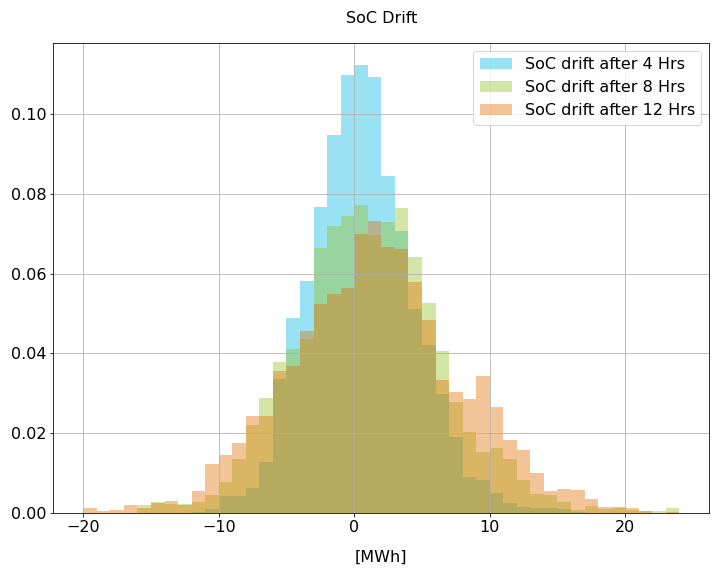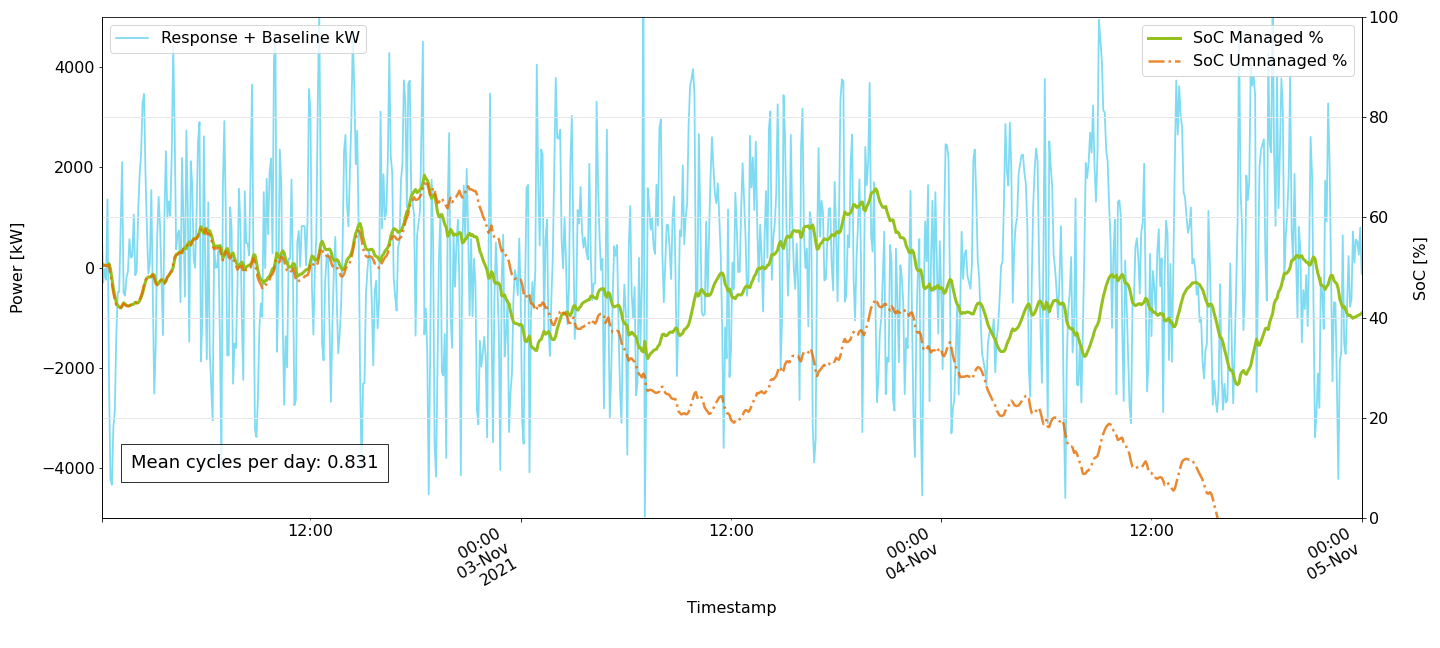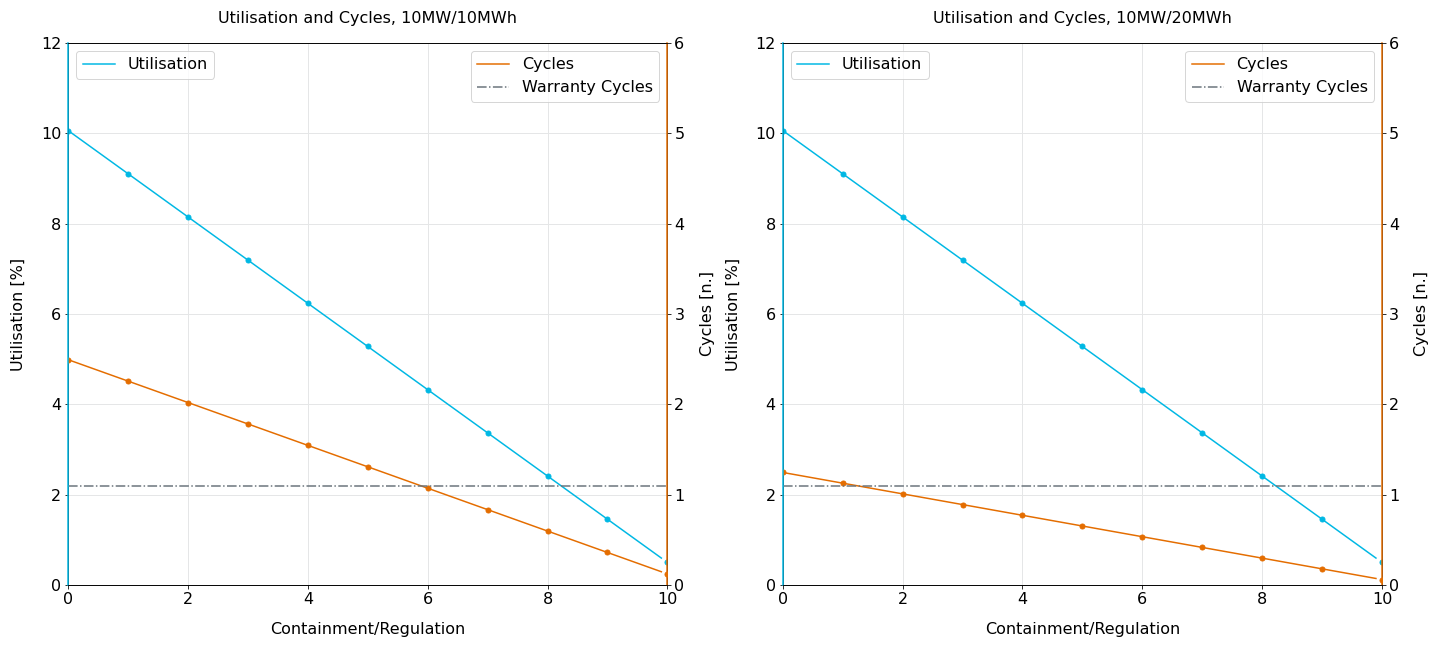A New Frontier in Dynamic Frequency. Does it stack up?
National Grid ESO’s new dynamic frequency regulation services suite needs fast-responding assets, such as batteries, to enhance grid frequency stability. Operators will be able to pick and choose the services they provide. However, managing the state of charge ahead of time and keeping systems within warranty constraints by stacking these new products to achieve desirable utilisation and revenues adds complexity.
As the National Grid ESO procures Dynamic Regulation with a minimum unit size of 1MW, it could mean significant underutilisation of most existing systems below a 2-hour duration. So what does this mean for the state of charge (SoC), and how we can create the optimum ‘stack’?
In this blog, we explore a theoretical battery’s response to the new Dynamic Response (DR) and Dynamic Moderation (DM) services, modelling the expected impacts to the utilisation, cycling, and State of Charge (SoC) management.
An Increasing Appetite for Energy Storage
The UK’s electricity system is increasingly experiencing lower inertia, and there is a growing risk of more considerable and frequent generation losses. Last year the publication of the Future Energy Scenarios (FES) from National Grid ESO (NGESO) and the Government’s Smart Systems and Flexibility Plan 2021 outlined the need and role for flexibility in a net-zero UK energy system. As variable renewable power replaces conventional generation sources, flexibility not only unlocks increasing potential for renewables and ensures energy security but could also reduce system costs by between £30-70bn by 2050. At least 15GW of shorter duration assets (less than 4 hours) will be needed by 2050 to help balance the system. According to the FES, by 2030, 18GW of shorter duration assets could be built in the fastest credible decarbonisation scenario.
New Frequency Services for a More Resilient, Lower Carbon System
In recent years we have seen a growing number of low-frequency events, where grid frequency has deviated by more than 0.3Hz (Figure 1). For example, on the 9th August 2019, we saw a blackout; 3% of system demand disconnected, and in London, 60% of the Tube network ground to a halt.
Figure 1. Number of lower than 49.7 Grid frequency events since 2014.
There are different strategies to combat dropping inertia:
procuring it directly from a conventional plant or synchronous generators;
reducing the size of the most significant single loss on the system (which reduces the risk of instability if that load is lost) or;
the procurement of faster frequency response.
Batteries enable the procurement of faster frequency response; they can react to significant frequency disturbances and restore stability in under a second by delivering ‘synthetic inertia’ to the system.
By April 2022, NGESO will have launched the full suite of new faster-acting frequency response services, eventually replacing all legacy frequency products, including Firm Frequency Response (FFR).
Introduced in October 2020, Dynamic Containment (DC) was the first of these new services, and it now has over 850MW of participating volume. DC operates post-fault, providing a less than 1-second response to frequency deviations of greater than 0.2Hz. DC helps the system recover from sudden significant losses of generation or load.
In March and April 2022, we expect the soft launch of Dynamic Moderation (DM) and Dynamic Regulation (DR). Both DM and DR are pre-fault services. DR acts with a constant and proportional power response across the ‘operational’ frequency range and reaches full power at a +/- 0.2Hz frequency deviation. DM kicks in between +/- 0.1Hz-0.2Hz, giving an additional boost to stabilise frequency as it moves towards the edge of operational limits. Figure 2 compares the droop curves (the power response according to grid frequency) for all three services with the existing FFR product.
Figure 2. Droop curves for Dynamic services (left) and FFR (right), showing the power response as % of nominal asset power across the frequency range in Hz.
The New Dynamic Services
Figure 2 shows that DR requires the highest comparative response due to its steep droop curve. We model the impact of performing this service for a 10MW system with infinite storage (i.e. with no energy limit to charging or discharging) using historic frequency data, accounting for efficiency losses.
DR has twice the utilisation of FFR, at 10% (Table 1), and subsequently double the throughput (cumulative discharge energy). DM and DC have much lower utilisation. A 1-hour system would perform 0.5 and 0.12 cycles per day, respectively, compared to 2.4 for DR.
Table 1: Average Utilisation (%) and average throughput (MWh/MW) for FFR and new dynamic services. Calculated from historic Grid frequency.
Figure 3 shows the expected power response to a large low frequency event (0.3Hz deviation). DR and DM act to restore grid frequency faster than FFR. While DR and DM services reach their maximum response power levels at or below 49.8 Hz, the DC response stays below 50% of its contracted level.
Figure 3. Response to >0.3Hz low grid frequency deviation for all Dynamic Services and FFR. Here, negative power indicates discharging of a battery.
DC acts in reserve should an additional loss push frequency further away from 50Hz. Theoretically, grid frequency should become more robust to system trips even as inertia continues to fall with these three services acting in concert – vital for the UK’s security of supply. Depending on how much volume NGESO procure, we may therefore anticipate grid frequency to depart from what we see in historic frequency data. The utilisation and throughput of each service may then look different, but using historic frequency still gives us a reasonable idea of what to expect.
The Impact on State of Charge
With the higher utilisation of DR, SoC management becomes increasingly crucial for batteries, ensuring a ‘real’ battery of finite capacity can deliver the service and consider the service’s cost.
In Figure 4, the first plot shows how much the SoC would drift in each of 20 days for the same 10MW system. The bottom histogram shows the SoC drift over EFA blocks 1, 2 or 3 for a more considerable period of historical data. With no actions taken to rebalance the stored energy of a system providing 10MW of DR for 8 hours—or 2 EFA blocks. SoC would have drifted by more than +/-5MWh, 35% of the time.
This scenario suggests that a 1-hour battery would fully charge or discharge to empty after just 2 EFA blocks if it begins delivering the service at 50% SoC, ignoring availability requirements.
Figure 4. State of charge drift of a battery providing Dynamic Regulation only.
Participants must provide the service continuously for the periods they have tendered for or risk penalties. Furthermore, NGESO has stipulated a 60-minute minimum energy requirement for energy-limited assets. That means even a 2-hour battery would need a rebalancing action within 8 hours (2 EFA blocks) 34% of the time, and within 12 hours (3 EFA blocks), 42% of the time. Alternatively, providers could de-rate the tendered volume (i.e. MW) offered, which would also be favourable to reduce cycling and preserve the system warranty.
Managing State of Charge
Baselining actions must be taken to manage SoC while a battery performs DR. We simulate a 10MW/10MWh battery, de-rated to 4MW, delivering DR over three days continuously. The SoC is managed with spare MW using an automated control algorithm that attempts to maintain a 4MWh of headroom and foot room, equivalent to a 60-minute energy requirement.
Following BM requirements, units performing DC baselining actions are planned 1-hour in advance. Under these conditions, the battery requires, on average, three rebalancing actions per day, with 3.8MWh of energy needed for baselining. Figure 5 shows simulated battery power and energy while responding to historical frequency deviations.
Figure 5. Simulated State of Charge with a 10MW, 1-hour battery responding to Grid frequency with a Dynamic Regulation response curve and a de-rated 4MW DR tender. Automated baselining is applied to maintain system energy around 50%.
Given the ahead-of-time baselining requirement, the rebalancing algorithm fails and leads to 5 hours per day outside the 60-minute minimum energy requirement for a 4MW tender on a 10MWh asset. So a 1C system de-rated to 40% of its nameplate capacity–in effect becomes a 0.4C (or 2.5h) system that could still cycle over 400 times per year and would still not meet a 60-minute minimum availability requirement.
Stacking Dynamic Services
National Grid ESO has stated that the three services can be stacked together (albeit not in the initial soft-launch phase). A single battery can deliver different services simultaneously but with each MW partitioned to provide a single service.
Since DR has high utilisation, we limit the DR tender to much less than the battery’s power rating. This prevents exceeding warranty limits on cycling and mitigates against the cost of a substantial SoC rebalancing regime, which may require peak-time charging to maintain availability.
To monetise the remaining MWs, we stack lower utilisation services on top. Figure 6 below shows a low grid frequency event under two scenarios: the first with a complete 10MW DR response; the second with a stacked tender of 5MW DR and 5MW DC. In the latter case, during a frequency event below 49.8Hz, utilisation averages 60% of the total tendered volume during the period, rather than 100% for the DR response alone.
Figure 6. Resulting power response of Regulation service vs stacked Regulation and Containment services during a low frequency event. N.B. negative power indicates discharging.
Towards an Optimal Stack
We can assess the ‘best’ stack for battery size by calculating utilisation and cycling for a range of tender stacking combinations. For example, figure 7 shows the utilisation and mean daily cycles when we combine DC and DR. The x-axis shows the share of DC, such that 10 represents 10MW of Containment and 0MW Regulation.
If we must also operate below a “Warranty Cycles” level set to 400 cycles per year, a 6MW/4MW split is best for a 1-hour system (LHS of 7). If we must not exceed 5% utilisation, we also require 6MW/4MW. However, note that since a 1-hour system will likely not provide more than 5MW DR because of the energy requirement limits, the trend below 5 is purely theoretical.
The right plot shows how a 2-hour battery (10MW/20MWh) could significantly loosen constraints on delivering the Regulation service – reaching 8MW of Regulation to 2MW of Containment before reaching the Cycles limit. But, of course, the optimal split should also consider revenue potential. The revenue potential depends on the available auction prices, which are also influenced by the National Grid ESO requirements and, otherwise, the technical barriers to participation.
Figure 7. Utilisation and number of daily cycles for a 10MW battery when different ratios of stacked dynamic services are chosen.
A Real-World Stacking Strategy
We simulate a potential ‘real-world’ scenario, stacking DR and DC. We choose a 2-hour battery with an 8-2 tender split between DR and DC to meet the cycling constraint of approximately 1.1 cycles per day (400/year). However, reserving capacity as headroom for managing energy, we need to de-rate the tender to 7MW-2MW, preferring the lower-utilisation service. Services are presumed to be symmetrical (both high and low response). Our SoC management aims to keep the system close to 50% and maintain the minimum energy requirement.
The optimum solution compromises between minimising the number of actions taken to balance SoC, which could be expensive, and taking sufficient measures to limit the chances of violating minimum energy constraints and protecting the battery’s life through minimising time spent at extremely high or low energies. Figure 8 shows the modelled response over three days.
With a 2MW/7MW DC/DR split, for a 10MW 2-hour system, we see ca. 7.3% utilisation and 0.83 cycles per day. Balancing SoC requires a mean daily baseline volume of 6.2MWh. Despite the current cost uncertainties associated with providing grid services (due to recent high electricity prices), the simulated case would, if exposed to only cash-out prices, cost more than £3/MW/H.
Whilst achievable compared to current FFR prices, we also have to consider the penalty of higher utilisation and the opportunity cost of going elsewhere for traded revenue.
Figure 8. Modelled Energy management with stacked dynamic services: 2MW Dynamic Containment to 7MW Dynamic Regulation. Mean daily cycles are under the target of 1.1.
In conclusion
Modelling the forecasted utilisation of 1C batteries with historical grid frequency can deliver DC and DM. However, the pre-fault DR service requires a significant MW de-rating or a longer duration battery to provide a sustained service energy requirement. Therefore, longer duration storage and higher cycling capability could offer good market commercialisation opportunities.
We can generate a greater return from batteries while keeping cycling within a ‘standard’ warranty by stacking high and low utilisation services. Modelling the delivery of this type of stacked service with historic grid frequency demonstrates a trade-off between efficient state of charge management and cost minimisation. Imposing operational constraints such as ahead-of-time rebalancing notification for a high utilisation service presents a challenge even for 2-hour systems. Taking baselining actions ahead of time and offering multiple services at once is operationally complex within system warranty constraints.
Furthermore, if National Grid ESO is to procure these services (particularly DR) with a minimum unit size of 1MW, it could mean significant underutilisation of battery capacity at the sub-10MW level. Ultimately, the prices of these services should reflect this complexity and potential inefficiency. Given the difference in utilisation and technical requirements, it will be fascinating to see where price levels transpire between the three services.
Unlocking the investment necessary to meet the ambitious storage goals of the Smart Systems and Flexibility Plan 2021 requires confidence in the revenue streams for these assets. The existing ‘stack’ of revenue streams open to storage assets can be uncertain and high risk, and barriers to entry remain. Economies of scale, volume caps, licencing, and changes to demand charges (namely the Targeted Charging Review) favour large standalone storage assets. More planning relaxation will further incentivise the building of systems greater than 50MWh.
These new markets will undoubtedly form an essential part of the flexibility revenue stack and should provide investors with confidence in storage revenues’ long-term security. Even without operational examples for Dynamic Regulation and Dynamic Moderation, as with Dynamic Containment, battery storage appears favourable to deliver these services at the lowest cost.
However, with wholesale market volatility, trading opportunities elsewhere may yet present a more attractive option for battery operators looking to maximise revenue stacking if the cost-of-service provision, combined with high technical barriers in grid services, outstrip the benefits.
To find out more about our products and services, contact us.
Written by Jonathan Bosch










